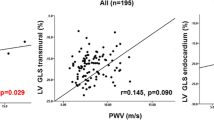Abstract
Left ventricular (LV) remodeling in systemic arterial hypertension causes electrical conduction delay and impairs synchronous contraction, which may contribute to the development of heart failure. This study aimed to assess the change of LV mechanics in hypertension by layer-specific dyssynchrony. One hundred and twenty-one patients with primary hypertension and LV ejection fraction >50 % (mean age, 62 ± 10 years) and 31 normotensive controls (mean age, 63 ± 9 years) were prospectively included. Layer-specific dyssynchrony index (DI) was defined as standard deviation of time interval (TI) from the onset of Q wave to peak longitudinal strain obtained from 18 segments in each endocardial, myocardial, and epicardial layer. The global TI between the onset of Q wave to peak global longitudinal strain in each layer was obtained and the time difference (TD) of global TI between layers was calculated. DIs were significantly different in three layers (P < 0.001 in both groups), and were significantly greater in hypertensive patients than in controls except epicardial DI. End diastolic filling pressure and LV global longitudinal strain were related with endocardial DI. TD between endocardium and myocardium was greater in hypertensive patients than in controls (P = 0.001). Layer-specific DI revealed delayed contraction in each layer and between layers in hypertensive patients, which were apparent in endocardium and between endocardium and myocardium. Increased layer-specific DIs were associated with subclinical LV dysfunction, although LV ejection fraction was preserved. These may be helpful to understand layer-specific mechanical property of LV myocardium and for early detection of subclinical impairment of myocardial function.




Similar content being viewed by others
References
Spragg DD, Kass DA (2006) Pathobiology of left ventricular dyssynchrony and resynchronization. Prog Cardiovasc Dis 49:26–41
Yang B, Chettiveettil D, Jones F, Aguero M, Lewis JF (2008) Left ventricular dyssynchrony in hypertensive patients without congestive heart failure. Clin Cardiol 31:597–601
Lip GY, Felmeden DC, Li-Saw-Hee FL, Beevers DG (2000) Hypertensive heart disease. A complex syndrome or a hypertensive ‘cardiomyopathy’? Eur Heart J 21:1653–1665
Berk BC, Fujiwara K, Lehoux S (2007) ECM remodeling in hypertensive heart disease. J Clin Invest 117:568–575
Opthof T, Coronel R, Janse MJ (2009) Is there a significant transmural gradient in repolarization time in the intact heart? Repolarization gradients in the intact heart. Circ Arrhythm Electrophysiol 2:89–96
Rohr S (2009) Myofibroblasts in diseased hearts: new players in cardiac arrhythmias? Heart Rhythm 6:848–856
Okin PM, Devereux RB, Kjeldsen SE, Edelman JM, Dahlof B (2009) Incidence of heart failure in relation to QRS duration during antihypertensive therapy: the LIFE study. J Hypertens 27:2271–2277
Chang SA, Kim HK, Kim DH, Kim YJ, Sohn DW, Oh BH, Park YB (2009) Left ventricular systolic and diastolic dyssynchrony in asymptomatic hypertensive patients. J Am Soc Echocardiogr 22:337–342
Kwon BJ, Jang SW, Choi KY, Kim DB, Cho EJ, Ihm SH, Youn HJ, Rho TH, Kim JH (2012) Impact of antihypertensive treatment on left ventricular systolic dyssynchrony in treatment-naive hypertensive patients. Hypertens Res 35:661–666
Lang RM, Bierig M, Devereux RB, Flachskampf FA, Foster E, Pellikka PA, Picard MH, Roman MJ, Seward J, Shanewise JS, Solomon SD, Spencer KT, Sutton MS, Stewart WJ, Chamber Quantification Writing Group, American Society of Echocardiography’s Guidelines and Standards Committee, European Association of Echocardiography (2005) Recommendations for chamber quantification: a report from the American Society of Echocardiography’s Guidelines and Standards Committee and the Chamber Quantification Writing Group, developed in conjunction with the European Association of Echocardiography, a branch of the European Society of Cardiology. J Am Soc Echocardiogr 18:1440–1463
Pirat B, Khoury DS, Hartley CJ, Tiller L, Rao L, Schulz DG, Nagueh SF, Zoghbi WA (2008) A novel feature-tracking echocardiographic method for the quantitation of regional myocardial function: validation in an animal model of ischemia-reperfusion. J Am Coll Cardiol 51:651–659
Kleber AG, Rudy Y (2004) Basic mechanisms of cardiac impulse propagation and associated arrhythmias. Physiol Rev 84:431–488
Mayet J, Hughes A (2003) Cardiac and vascular pathophysiology in hypertension. Heart 89:1104–1109
de Bakker JM, van Rijen HM (2006) Continuous and discontinuous propagation in heart muscle. J Cardiovasc Electrophysiol 17:567–573
Tsamis A, Bothe W, Kvitting JP, Swanson JC, Miller DC, Kuhl E (2011) Active contraction of cardiac muscle: in vivo characterization of mechanical activation sequences in the beating heart. J Mech Behav Biomed Mater 4:1167–1176
Fujiwara S, Komamura K, Nakabo A, Masaki M, Fukui M, Sugahara M, Itohara K, Soyama Y, Goda A, Hirotani S, Mano T, Masuyama T (2014) The association between left ventricular twisting motion and mechanical dyssynchrony: a three-dimensional speckle tracking study. Heart Vessels. doi:10.1007/s00380-014-0586-4
Kwon BJ, Jang SW, Choi KY, Lee JB, Kim DB, Cho EJ, Ihm SH, Youn HJ, Rho TH, Kim JH (2013) Independent determinants for presence and degree of left ventricular systolic dyssynchrony in treatment-naive patients with hypertension. J Hypertens 31:601–609 (discussion 609)
Nakamura N, Hirata K, Imanishi T, Kuroi A, Arita Y, Ikejima H, Tsujioka H, Takemoto K, Tanimoto T, Kitabata H, Takarada S, Kubo T, Mizukoshi M, Tanaka A, Arita M, Akasaka T (2011) Electrocardiographic strain and endomyocardial radial strain in hypertensive patients. Int J Cardiol 150:319–324
Sanderson JE (2007) Heart failure with a normal ejection fraction. Heart 93:155–158
Acknowledgments
We sincerely thank Jeong-Hyang Kim and Young-Woon Choi for obtaining images and collecting data. This study was supported by a Korea University Grant (Park SM).
Conflict of interest
None declared.
Author information
Authors and Affiliations
Corresponding author
Rights and permissions
About this article
Cite this article
Kim, SA., Kim, MN., Shim, WJ. et al. Layer-specific dyssynchrony and its relationship to the change of left ventricular function in hypertensive patients. Heart Vessels 31, 528–534 (2016). https://doi.org/10.1007/s00380-014-0626-0
Received:
Accepted:
Published:
Issue Date:
DOI: https://doi.org/10.1007/s00380-014-0626-0



